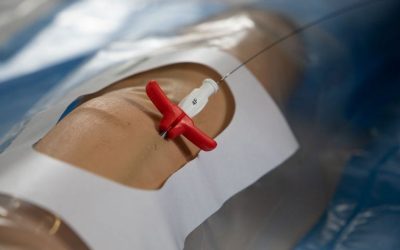In ultrasound-guided procedures, it is possible that an ideal vein isn’t found in the optimal catheter exit zone. When confronted with the decision between “immediate placement of a line out of necessity for the patient” and “waiting for potential alternatives,” healthcare professionals might have to insert a catheter into a vein that’s exceptionally narrow or even too slender for the catheter’s size. Nonetheless, alternative options do exist.
Tunnelling presents itself as a valuable solution, but its viability and safety for midline-type catheters come into question. This article aims to address that very inquiry.
-
Definition of tunnelling
This procedure entails forming a subcutaneous tunnel connecting the venous puncture site to the catheter exit point on the skin.
-
When is tunnelling indicated?
According to Dawson’s ZIM method, the arm is categorized into three zones for intravenous catheter placement:
Two zones unsuitable for insertion:
– The red zone, located in the lower third of the arm: not recommended due to its proximity to the flexure, which raises the risk of mechanical phlebitis and catheter malfunction in a mobile area.
– The yellow zone, situated in the upper third of the arm: not recommended due to its proximity to the armpit, which increases the risk of infection due to sweat accumulation, as well as the risk of movement near the shoulder joint.
One appropriate puncture zone: the green zone, located in the middle third of the arm, harbours the brachial vein. This zone boasts a wide diameter and is distant from the median nerve and arteries.
When a DIVA (Difficult Intravenous Access) patient’s veins are depleted in the green zone, tunnelling becomes a pivotal technique to ensure line placement and effective treatment delivery. Another critical situation necessitating tunnelling arises when veins in the green zone don’t allow to maintain the 33% Catheter-to-Vein Ratio. Accessing a larger-calibre vein in a different region becomes imperative.
To address this, when using the RaPeVA method for vascular mapping, healthcare practitioners identify the best vein situated in the yellow zone (ZIM). This strategic approach facilitates the following steps during the placement procedure:
– Puncturing the targeted vein.
– Establishing a subcutaneous tunnel.
– Guiding the catheter through the tunnel and extending it to the level of the green zone.
Selecting a larger-calibre vein in the red zone isn’t viable, as it would be positioned below the catheter exit point and within a mobile area.
-
Tunnelling technique steps
Two types of tunnelling exist: anterograde and retrograde. In midline applications, the anterograde technique is primarily used and involves the following steps:
At the end of tunnelling, tissue adhesive, specifically cyanoacrylate, is applied to close the incision made at the venous puncture site.
-
Evolution of retrograde tunnelling in midlines
Not long ago, the practice of tunnelling for vascular access, involving external components, was limited to specific devices such as Hickman catheters and haemodialysis catheters. However, as technology and vascular access techniques have advanced, tunnelling has expanded to encompass various catheter types, thanks to specialized vascular access expertise, particularly within the nursing field.
In this regard, tunnelling is more used with PICCs due to their enhanced clinical versatility and longer length. While tunnelling is feasible with any PICC, its suitability for midlines depends on their length, as not all midlines are conducive to this technique.
Two recent studies confirm the feasibility of tunnelling with midline catheters and emphasize its crucial role when options are limited within the green zone of the ZIM method:
In a case study by Fabiani et al., tunnelling was employed for a 60-year-old woman post-cardiac surgery, where the axillary vein was the sole suitable option for catheterization. A 14G short catheter was utilized for the tunnelling procedure.
“The catheter presented no complications, was used for multiple daily infusions and blood draws, and remained functional throughout the 50-day treatment period.”
In Giustivi et al.’s study, tunnelling was performed in 110 out of 183 midlines to adhere to the Catheter-to-Vein Ratio (CVR), encompassing specific situations like paediatric cases, burn patients, skin lesions, and the requirement for a larger-calibre catheter (5 or 6Fr).
“The anterograde tunnelling technique with a blunt channelizer in midlines is a straightforward, fast, and regarded as a secure manoeuvre.”
-
Tunnelling limitations
When considering tunnelling within the yellow zone for venous cannulation, healthcare professionals might face certain challenges:
– Maintaining the Catheter-to-Vein Ratio (CVR) can be problematic, even in areas where veins are typically thicker.
– Skin lesions may hinder successful puncture.
– Pre-existing thrombosis in the chosen vein can pose a constraint.
Furthermore, tunnelling might not be a feasible choice in the green zone if:
– Skin conditions, such as lesions, burns, or MARSI, are unsuitable for the procedure.
– There isn’t enough space to perform tunnelling, which can be the case with neonates or small children.
Failure to adhere to the CVR can result in complications, as reducing blood flow due to catheter size significantly heightens the risk of thrombosis.
Tunnelling offers a solution in complex situations where standard cannulation isn’t advisable, providing an alternative to central access options like ports or Hickman lines, particularly for chronic patients in such cases.
References:
Gupta et al., “Tunneled and routine peripherally inserted central catheters placement in adult and pediatric population: review, technical feasibility, and troubleshooting,” Quant Imaging Med Surg. Apr; 11(4): 1619–1627 – 2021.
Xiao et al., “Subcutaneous tunneling technique to improve outcomes for patients undergoing chemotherapy with peripherally inserted central catheters: a randomized controlled trial,” J Int Med Res. Apr; 49(4) – 2021.
Pittiruti, Scoppettuolo, “Manual GAVeCeLT sobre PICCs y midline,” edición Edra – 2016.
Fabiani et al., “Tunnelling a midline catheter: When the traffic light shifts from yellow to green,” Sage Journals, Volume 19, Issue 6, April – 2018.
Giustivi et al., “Tunneling technique of PICCs and Midline catheters,” J Vasc Acces, Jul; 23(4): 610-614 – 2022.







